The exotic fruits of Asia
The exotic fruits of Asia
Every time I travel around Asia, I see and try new things, which I would like to write about. This time I want to focus on the exotic fruits of Asia, which average Europeans don’t know. Rich in vitamins and nutrients tropical treasures, which help to achieve good mood, is a topic that must be discussed. Mangosteen, lanzones, rambutan, jackfruit, lychee, longan, carambola, santol, pomelo, salak, marang, or durian – these are just some of the wonderful gifts of nature waiting for travellers.
Fruits of Asia – introduction
When travelling around Asia, I am always under great impression off the wonderful nature, interesting culture and rich flavours. Whenever I travel around that beautiful, extensive continent, I always see new things which I would like to write about, and this time I will only concentrate on the tropical fruits of Asia, which were delicious.

A young Filipina selling fruit at the bazaar.
Europeans usually think that in the well-stocked European countries, where the stores are full of goods from around the world, there isn’t such thing that they would not try. This approach however is very wrong, because when travelling in the Philippines, Borneo, Cambodia or Thailand, I tried many kinds of fruit that are unknown in Europe. Asia is very rich in that respect, because it can enchant white travellers with the gifts of nature, which are at their fingertips. Wealth, prosperity, peace and health are not always synonymous with money.
In my article I am going to briefly talk about several tropical fruits of Asia, with photos and some information about their appearance, taste, origin and health benefits. I also realize that I cannot describe all the tropical fruits of Asia, but I will try to include as many as possible. The following names may be taken differently by Asians from different parts of that continent, as certain fruit names are used in the Philippines, others in Malaysia or in Thailand. I also advise diabetics to find out which fruit they shouldn’t eat in large quantities, because in my article I only mention very briefly about it.

Asian fruit stall. In the photo. Among many: mangosteen, rambutan and mango.
Tropical fruit which I will not describe
I’m not going to describe those fruit, which are widely available and therefore common in Europe, because I want my article to be interesting. Fortunately, many tropical fruit from many continents are already available in Europe, but still not all. The Asian fruit available in Europe today are mangoes, which come from parts of Burma and eastern India; as well as kiwis that come from China, near Yangtze River. The origin of bananas might be also quite a surprise, as there are many kinds of them, and not just yellow but also red ones. Bananas come from Southeast Asia, and are widespread on all continents.
For example figs also come from Asia, even though they very often grow in favourable for them climates of Greece and Bulgaria, and for that reason I will not describe them neither. Other very common fruits are also peaches that come from China, and apricots from Armenia; but the same as in previous cases, those fruit also grow in southern Europe, and there are plenty of them. Grapes are also well known to Europeans, and the written sources prove one of their type to be from Turkey, and another from North America. For that reason I will not describe the fruit, which every Pole can buy in a shop.

Bananas on a tree are a common sight in Southeast Asia.
When traveling around Asia, I also saw many tropical fruit which to some extent are common in Asia and Europe, even though they originate from Latin America. For that reason, I will not describe passion fruit, papaya, avocado and dragon fruit, because these fruit come from Central and South America. Although when I was in Malaysia, I picked passion fruit from a tree, in the Philippines I went to a dragon fruit plantation, and when I was traveling in Sri Lanka and Burma, I shaked down down papayas from trees. However, those fruit are not Asian, and that’s why I leave their description to travellers specializing in Latin America. When I went to the Philippine island of Guimaras, I also tried chico fruit, even though they also come from Mexico and Central America. Now however, they grow in any tropical climate, including Asia. It was also a very interesting experience for me, when I tasted guyabano (soursop, sustard apple) in the Philippines, and which also comes from South America.
Watermelons on the other hand come from the Kalahari desert in Africa, although they are grown in Asia and in the southern states of the USA. Melons are also African, and there are a lot of them in Europe and in Asia.
This is my list of the exotic fruits of Asia:
Lychee – is a fruit that originates from China, but it is also very popular in India and in south-east Asia. Lychee grows on evergreen trees sometimes reaching 30m in height. Lychee is very widespread in Asian bazaars, because of the sweet taste, reminiscent of grapes, and with the addition of citrus and rose water flavour. In the middle there is a black seed, and around it a white and pink fruit, which is sweet, soft and refreshing in a hot, tropical climate. Lychee is also a very popular dessert in Thailand, and this fruit is often added to ice cream, it is preserved, and processed into juices and sodas. When I was in the Philippines, I also tried lychee tea, and the fruit has many uses. Lychee is a kind of fruit that people have never enough.
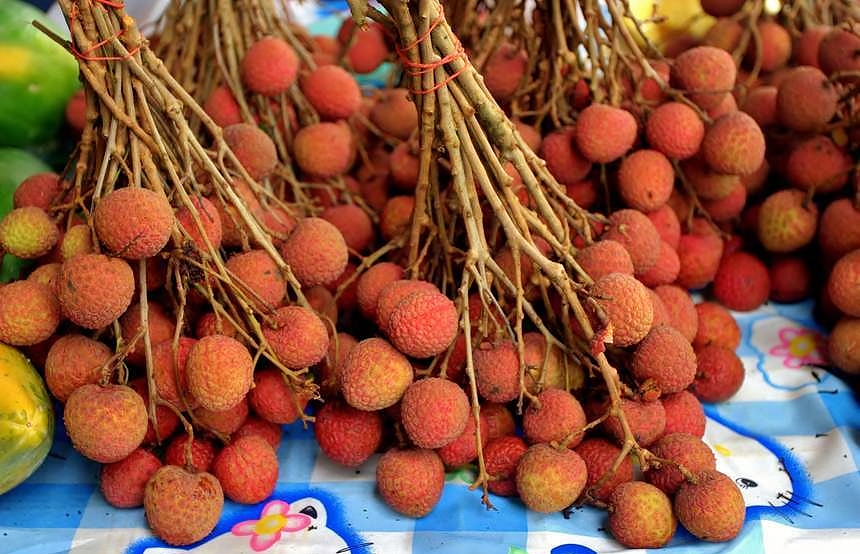
Lychee at a bazaar in Asia.
Lychee has many advantages. It is rich in dietary fiber, which works well for digestion. In addition, it has a lot of phosphorus, magnesium and copper, which is good for bones. Lychee also increases immunity as it is rich in vitamin C, it regulates pressure and it’s good for heart. However, there are reports that hundreds of Indian children died due to eating large amounts of lychees on empty stomachs.
An important piece of information is that lychee is surrounded by a thin and smooth, pink skin, which distinguishes it from rambutan, which I will describe below.
Rambutan – is a fruit that resembles lychee, but there are several differences between those two. First of all, rambutan comes from Malaysia and Indonesia, and not from China, like lychee. In addition, rambutan trees reach only about 5m, the rambutan peel is thicker and covered with small bushes, and the fruit itself is also a little bigger and not as sweet as lychee.
Rambutan also has many vitamins, including iron and vitamin C, but it has more calories and more fibre. Just like lychee, rambutan has a black seed, surrounded by a delicate white fruit, though not as delicate as lychee.

On the left we can see rambutan, and on the right marang. Lanzones are the back.
Longan – is another relative of lychees, which inexperienced travellers would find difficult to distinguish. Longan also comes from south-east Asia, but it’s a bit smaller than lychees. The size resembles olives, but it has hard, light-brown skin, black seed, and it has taste and structure similar to lychees. I think it is more similar in taste to rambutan, because it is just as jelly-like and more tart.
Longan is so rich in vitamins that it is used in traditional Chinese medicine to improve skin, heart health and calmness. It is very rich in vitamin C and it’s a source of potassium and phenolic acid, an antioxidant with antifungal, antiviral and antibacterial properties.
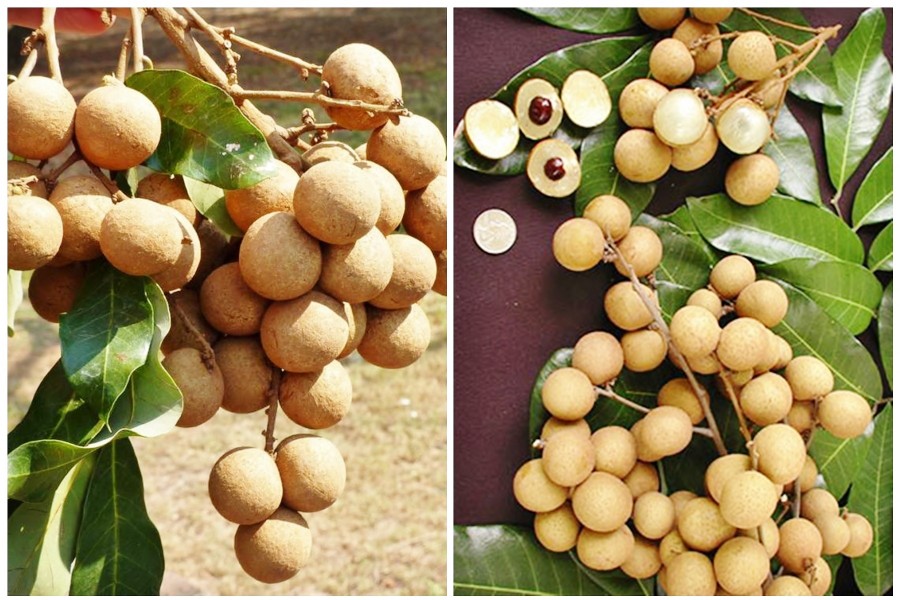
Longan – a close relative of lychee.
Lanzones / Langsat – is a fruit that will never run out in the Philippine bazaars, but unfortunately in Europe it appears less often than truth in the British politics. Lanzones (Filipino name), or Langsat (Malay name) comes from western Malaysia and it iss the most popular in the Philippines and Indonesia. Lanzones which grow in the Philippines are seasonal and mostly present in the southern islands. It is sold in bunches resembling grapes, but Lanzones fruit are about twice as large. Lanzones are light beige, and under the thin skin there is a white, delicate sweet fruit divided into segments. Although the taste is sometimes compared to grapefruit, it is less bitter and not filled with juice. Inside some segments of lanzones there are dark seeds. I chewed them a few times because they are soft, but very bitter. Lanzones fruit are very refreshing, light on stomach, and they are often used as a very healthy and tasty dessert. Importantly, hands must be washed after eating, because they are very sticky.
Lanzones is one of my favourite tropical fruit. It has a very good taste, and has sweetness and character, which is not found in European fruit. Lanzones provides a very healthy diet and it’s good for digestion, as it has many vitamins and beneficial nutrients. It contains minerals such as iron, zinc, potassium, phosphorus, magnesium, manganese, copper and calcium.

Lanzones / langsat, and mango.
Mangosteen – is another tropical fruit, also known as purple mangosteen. It comes from Malaysia and Indonesia, but it is also popular in the Philippines and Sri Lanka.
Mangosteen is round, purple and covered with a green chalice, that holds it on the stalk. The outer skin of the fruit is thick and rubbery, while in the inside it is sweet, tasty, and consists of snow-white segments which resemble the orange pattern. Each segment contains from one to four seeds with a very bitter taste. In the Philippines, mangosteen grows mainly on Mindanao, from where it is exported to other parts of the country. Mangosteen smells strongly and has a slightly sour taste, which according to some travelers resembles a mixture of orange and peach. In my experience, the adventure with mangosteen begins with its peeling, because one must press it hard to extract the white fruit divided into white segments. I also advise to eat carefully, because the bitter pits are sometimes huge and biting them is not pleasant.
As for the health information that I found on this fruit, mangosteen is low in calories and high in fibre, and it has many essential nutrients, even though it does not contain saturated fat or cholesterol. The potassium content helps to control heart rate and regulate blood pressure, which in turn helps to prevent stroke and heart disease. Mangosteen also helps to regulate the menstrual cycle, is effective in fighting obesity and improves skin health. There are also healthy amounts of manganese and magnesium, and new research suggests that xanthones – a powerful antioxidant that occurs almost exclusively in mangosteen – has properties that combat pain, allergies, infections, skin diseases and fatigue, while supporting intestinal health.

Mangosteen – delicasy of Asia.
Mangosteen also contains vitamin C and has B vitamins, such as thiamine, niacin and folic acid, which help to metabolize carbohydrates, proteins and fats. Generally mangosteen has been considered to be a witamim bomb, although I also found an opinion that mangosteen must be ate in moderation, because it contains fructose, which can be harmful to health in excessive amounts.
Santol (katon) – I refer to santol as “another variant of mangosteen”. Santol fruit is round, juicy and reaches the size of an apple. Inside santol there are 3 to 5 white juicy segments with brown seeds, which are inedible. I saw a lot of santols in Philippine bazaars, which are usually available in large quantities. The taste of the fruit is a bit sour when it is not yet ripe, and that’s why people use santol to make marmalade, but they also add some salt to it. However, when it is ripe, the fruit becomes really sweet.
Santol trees are high, as they reach from 15m to even 45m in height, and are covered with lush green leaves. Each tree is very efficient, because it gives about 18,000 to 24,000 fruit. In addition, santol is divided into two main types: yellow and red. Red santols are larger and have harder skin, and yellow santols are sweeter.
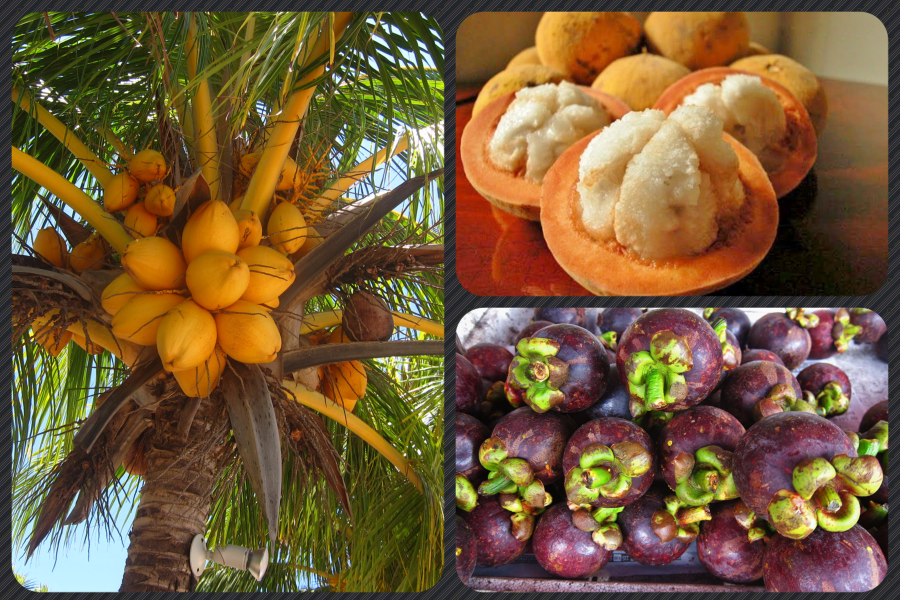
Santol, also called “wild mangosteen” is shown in the upper right corner.
According to the health information that I was able to find, some parts of the santol plant have anti-inflammatory properties. They are used to treat diarrhea and dysentery. The aromatic root is also a strong remedy for diarrhea. The root of santol also works well on the stomach. Santol contains many vitamins from B and C group, and therefore can prevent scurvy, and is a great antioxidant that helps to prevent cardiovascular disease, stroke and cancer. Because santol contains a lot of B vitamins, it improves our mood, speeds up metabolism and contains folic acid. Santol is very healthy.
Jackfruit – was one of my favourite fruit. When traveling in the Philippines, Thailand or Malaysia, I saw a lot of jackfruit, both in the bazaars and wild ones growing in the jungle. Jackfruit comes from south-west India, where it is most common, but then it also spread to Southeast Asia; mainly to the Philippines, Thailand, Malaysia and Indonesia. In general, jackfruit feels best in a warm, tropical climate, which is why it also grows in South America, Africa, Australia and some southern states of the USA.
When crossing the wild areas of the Philippines, I saw huge trees, from which hung large, green, oblong fruit with an uneven surface. Inside jackfruit there are many light yellow, plump tubers that are edible and connected to one core. After cutting it, the tubers have to be removed from the inside, because they are additionally attached to the surrounding yellow body. Each yellow bulb has one seed in it, which can be also boiled, and even ground into flour. When I was in the Philippines I saw a jackfruit, which weighed about 50kg and measured about 1 meter, but usually these fruit are smaller and do not weigh more than 10-20kg.

Jackfruit, which I saw hanging on a tree in the jungle of the Philippines.
In addition, jackfruit is a very good meat substitute, because it has a chicken-like texture, and although its fruit are sweet and smell nice, jackfruit has a fairly neutral smell, which is why it is used in many different dishes. Jackfruit is prepared sweet and spicy, in Indian and Malay cuisine, and it is also packaged in cans, even though it is mainly eaten as a sweet and very healthy dessert. According to nutrition experts, jackfruit could easily feed the whole world, because it doesn’t have to be grown on the agricultural land, it grows everywhere in a tropical climate, and one tree can produce up to three tons of food per year. Only because of that one plant, I think that there should never be any hunger in most of Africa and the Indian Subcontinent. What’s more, jackfruit plant would not only feed the black population of the world, but it also harmonizes perfectly with the natural environment. (Well, hunger is a war tactic planned to control nations based on basic needs.)
When it comes to vitamins and health benefits, I believe that jackfruit contains the entire pharmacy, given in a homeopathic way. Jackfruit improves digestion, it is good for bones, beneficial to eyesight and skin condition, it prevents cancer, it is good for heart and immune system, and it boosts energy. Jackfruit is rich in vitamin C and B, and ground jackfruit seeds added to dishes are rich in iron, lime, potassium and proteins. However, not many people know how to cut a jackfruit, and I think travellers should leave this task to Asians, who are simply better at it.

A big jackfruit, at the bazaar in Cebu City. Philippines.
Marang – is a “small version of jackfruit”, what means that it’s a fruit that looks similar, but it is smaller, more delicate, and there are white tubers inside, not yellow. When marang is ripe, one can open it with fingers. It is very popular in the bazaars of the Philippines and Borneo, where it comes from.
At first, marang doesn’t smell too inviting, that’s why I think it is better to open it outside, even though it doesn’t smell as drastically as durian. The sweet smell of white marang bulbs reminds me of the combination of bananas, pears and jackfruit. Pips can be roasted or boiled, and are also a good snack.

Marang – sweet, delicious, and easy to peel.
Marang is rich in vitamins A and C, beta-carotene, protein, fat, carbohydrates, calcium, iron, phosphorus and retinol. Marang, in addition to the sweet taste and the adventure associated with its peeling, or even discovering this fruit, also reduces blood pressure and t’s good for heart. People with diabetes should consult with doctor if they can eat marang, and in what quantities.
Noni – is a small fruit from Asia and Australia, which also grows in Hawaii on small green bushes. It is usually used for juice production, but not only. Sometimes it is cut in half, and then its delicate white fruit is eaten with a spoon. However, it is most often squeezed and drunk, rather than eaten. Noni juice is unfortunately insipid, and that’s why it is often mixed with other juices, such as grape juice or peach juice, although fruit syrup can be added to it too.
Noni is also sold in powder and capsules as a healthy addition to food, but it must be ensured that it is healthy for pregnant and breastfeeding women. I also read that Noni is not safe for people with kidney problems. In addition, noni helps with arthritis, reduces pain and swelling, and has several compounds that have anti-cancer properties.
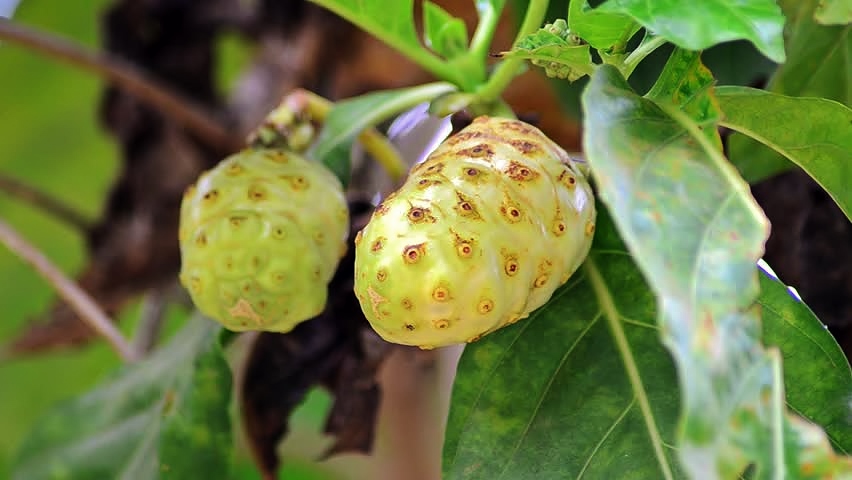
Noni – good taste and health at your fingertips.
Durian – is a large oval fruit covered with dangerous spikes, which weighs up to over 3kg. Considering its dangerous spikes and the weight of the fruit, it is enough to penetrate the skin, that’s why one has to keep it in thick gloves. The appearance of durian itself looks dangerous, but it is nothing compared to its stench, which is so strong that it even penetrates through its thick skin. Durian in often not allowed in hotels, underground stations or other public places. When I was in Malaysia I saw penalties for bringing durians to hotels, and taxis in Singapore also don’t want to carry it, because the stench remains for a long time.
Durian is a popular and a very healthy snack in Southeast Asia, although it does not smell well. When it comes to taste, it’s hard to describe it because durian is so unique. I don’t advise eating durian immediately after it falls off a tree, even when it is ripe, because then it is still bitter and hard. It is worth to wait for a while, so it is really mature, and become yellow falling into orange, because then it is sweet and soft. The taste of durian is difficult to describe, but I call it a mixture of bitter, sweet and creamy. Each durian usually consists of 3 to 5 large, yellow segments, with huge pits inside them. The stench however always remains, that’s why I don’t advise anyone to kiss after eating durian.
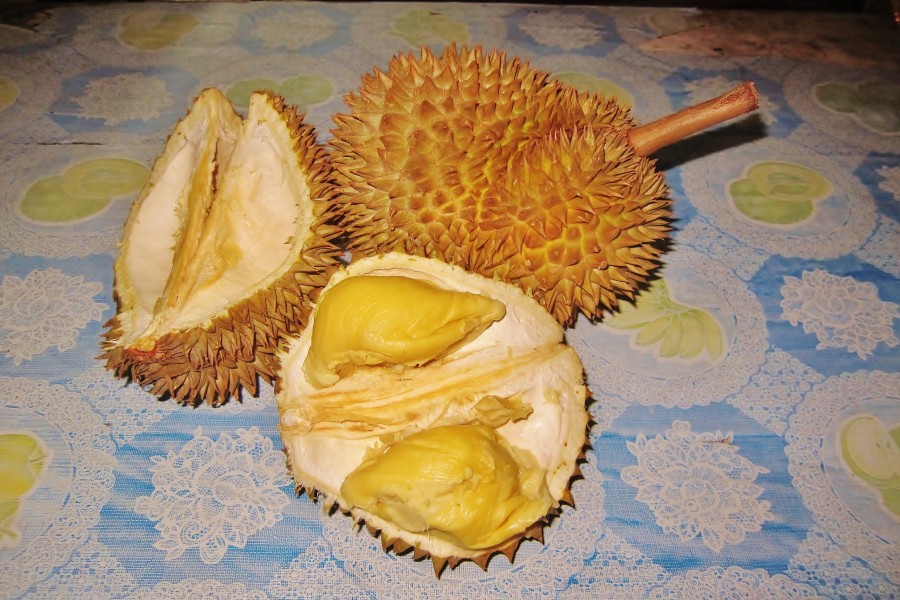
Cut durian.
Durian is rich in vitamin C, it is good for fever, skin irritation and jaundice. Durian is also good as an anti-cancer medication, it is good for heart, it fights infections, and controls the level of sugar in blood.
When traveling around Southeast Asia I noticed that durian is used for making a lot of tasty desserts and beverages, and it is sometimes also added as an appetizer to main dishes. In Malaysia, I ate durian biscuits and durian ice cream, which were very tasty. I also bought a lot of delicious durian coffee, which was supposedly “collected by proboscis monkeys”.
There are about 30 different varieties of durian, although to white tourist they all look the same. The fruit comes from Malaysia, Indonesia and Borneo, although there are also durian farms in Sri Lanka, southern India, Cambodia, Vietnam, Thailand and the Chinese island of Hainan. Thailand is the largest durian exporter, and has farms that grow many of its species. Very importantly, I don’t advise anyone to walk under durian trees, because falling fruit are dangerous. Imagine that 3kg stone covered with spikes falls on someone’s head.
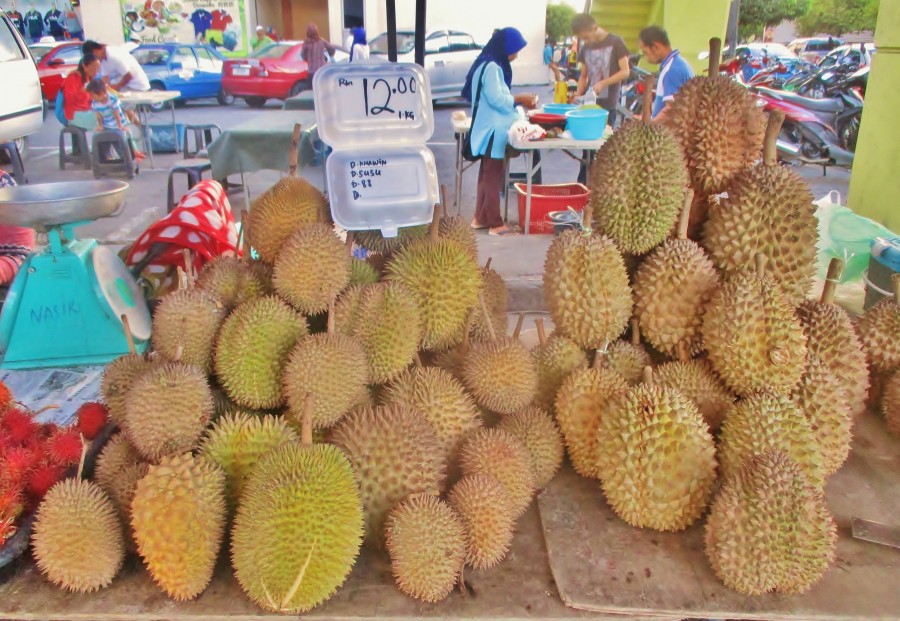
Durians at a Malaysian market.
I think that durian is a wonderful culinary experience of Asia and it must be tried. Some would love it, and others would prefer to stay away. However, I don’t advise white people to cut it on their own, because they don’t know how to do it. For that reason, let’s leave cutting durians to Asians, because they know how.
Salak (snake fruit) – is a species of small, green palm, originating from Java and Sumatra in Indonesia, although it is also currently grown in other parts of Southeast Asia. Salak can be bought in bazaars throughout the entire Southeast Asian region. It is called”fruit snake” because of its brown skin covered with scales, which is also prickly like a cactus. Inside, salak is sweet, but at the same time slightly sour and very juicy. In the middle the fruit are white, and usually divided into three lobes, in which there is an inedible pip.
Salak is mostly sold in bunches, and sometimes, after tipping Thai or Malaysian sellers, they are happy to peel it. In Southeast Asia salak is a healthy “fast-food”, to which Asians add salt or sugar, but there are reports that this fruit can cause constipation. For that reason I advise to eat a lot of mangoes, bananas and citruses, and salak treat as an extra snack. In addition, salak is used to make jams and biscuits. Salak is rich in vitamins, such as vitamin C and A, and has a lot of nutrients, including a lot of fibre, potassium, iron, calcium, protein, sugars and phosphorus.
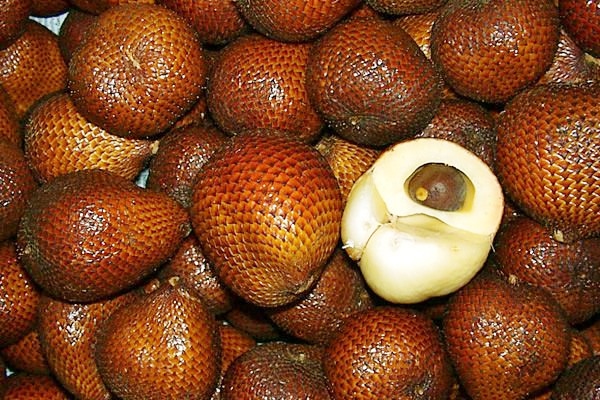
Salak (fruit snake), from Indonesia. It’s a must try.
Pomelo – is a citrus, which I personally refer to as the “tropical version of a grapefruit”, and which comes from the southern and south-eastern Asia. Pomelo skin is soft and easy to peel, and it is mostly yellow and green. In the middle there is a yellow or red citrus fruit divided into many segments, which in my opinion does not differ much from grapefruit. Pomelo in taste is sweet, but also slightly sour.
Pomelo has a lot of vitamin C, B6, potassium, fibre, magnesium, calcium, iron and zinc, to name just a few of them. Pomelo helps digestion, strengthens immunity, and it is good for the treatment of constipation and dehydration. Pomelo is also good for hair and skin, it helps in wound healing, it is good for bones, it regulates blood pressure, it is good for fighting obesity, and it prevents cramping.
I will also add that it is very easy to confuse pomelo with grapefruit, even though it’s a different fruit from the same family. Pomelo comes from Malaysia and it is the largest citrus in the world, while grapefruit was found in Barbados, and is the second largest citrus.

At the bazaar in the Philippines,in front of pomelos. Quite often, this fruit is sold on trays, so there is no need to peel.
Star fruit (carambola) – is a tropical fruit of Asia, which originates from Indonesia, Malaysia and the Philippines, although it is now also grown in other tropical parts of the world. Carambola is green and yellow, and its name “dragon fruit” comes from the fact, that after cutting it into many parts it looks like a star.
The taste of carambola is sour and tart, and sweet when it is really ripe. The taste of carambola is also compared to apple, grape, pears and citrus. In that case, there is no need to peel the fruit off its wax skin, because the whole carambola is edible. Due to its taste, carambola is added to many drinks and desserts, and sometimes you can also see its yellow star on the edge of glasses in alcoholic beverages.
In my opinion “star fruit” are delicious and you should definitely try them. They have low calories, are rich in vitamin C, fibre and antioxidants. Unfortunately, there are reports that people with kidney problems or taking prescribed medications should consult a doctor before eating carambolas. The problem is in the toxins present in carambolas, which people with healthy kidneys can easily expel, while people with kidney failure keep the star fruit toxins in their bodies, what causes serious illnesses.
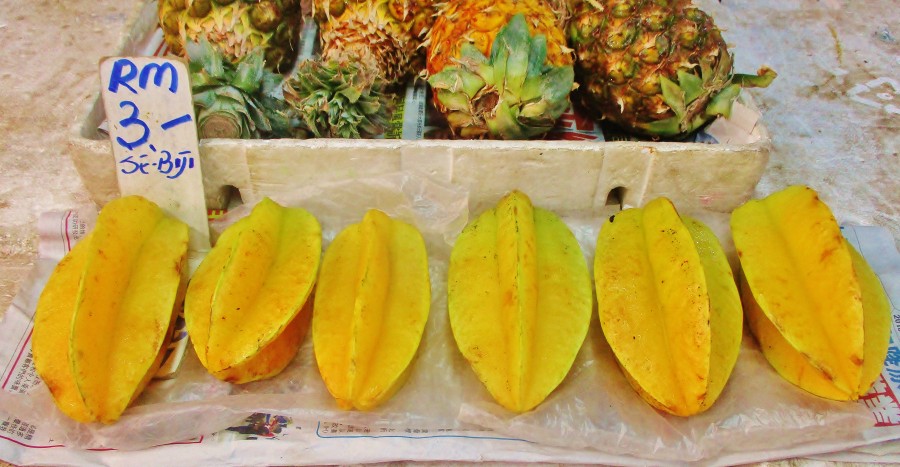
Star fruit (carambola), at the bazaar in Malaysia.
In addition, substances found in star fruit can affect a brain and cause neurological disorders. This toxic substance is called neurotoxin.
For most people however, this star-shaped fruit is a healthy and tasty addition to the diet. For a better advice on carambola, I advise to visit doctors in Thailand or the Philippines.
Calamansi – is a small citrus from South-East Asia, which is half the size of a mandarin. It is usually green, sometimes yellow and orange, and is most often used for juice production. Calamansi is very popular in Malaysia and the Philippines, where it comes from, but it also grows in other warm corners of the world. When I travelled around Malaysia and the Philippines, it was always abundant in bazaars, and I often squeezed it to my tea and drank juices from it.
Calamansi, also known as Philippine lemonade, is often used in by cooks, for all kinds of dishes and teas, and in the Philippines they also use it for making marmalade and they add honey to it. Apparently, Asian women who want to have whiter skin, use calamansi for skin whitening. By the way, there are skin whitening creams in China, and calamans in the Philippines, but I don’t know if they work that way.
The most important advantages of calamansi juice is support of the immune system and ability to relieve acidity in a stomach. Calamansi is also good for skin and its cleansing, for diabetes, respiratory system, and it reduces cholesterol.
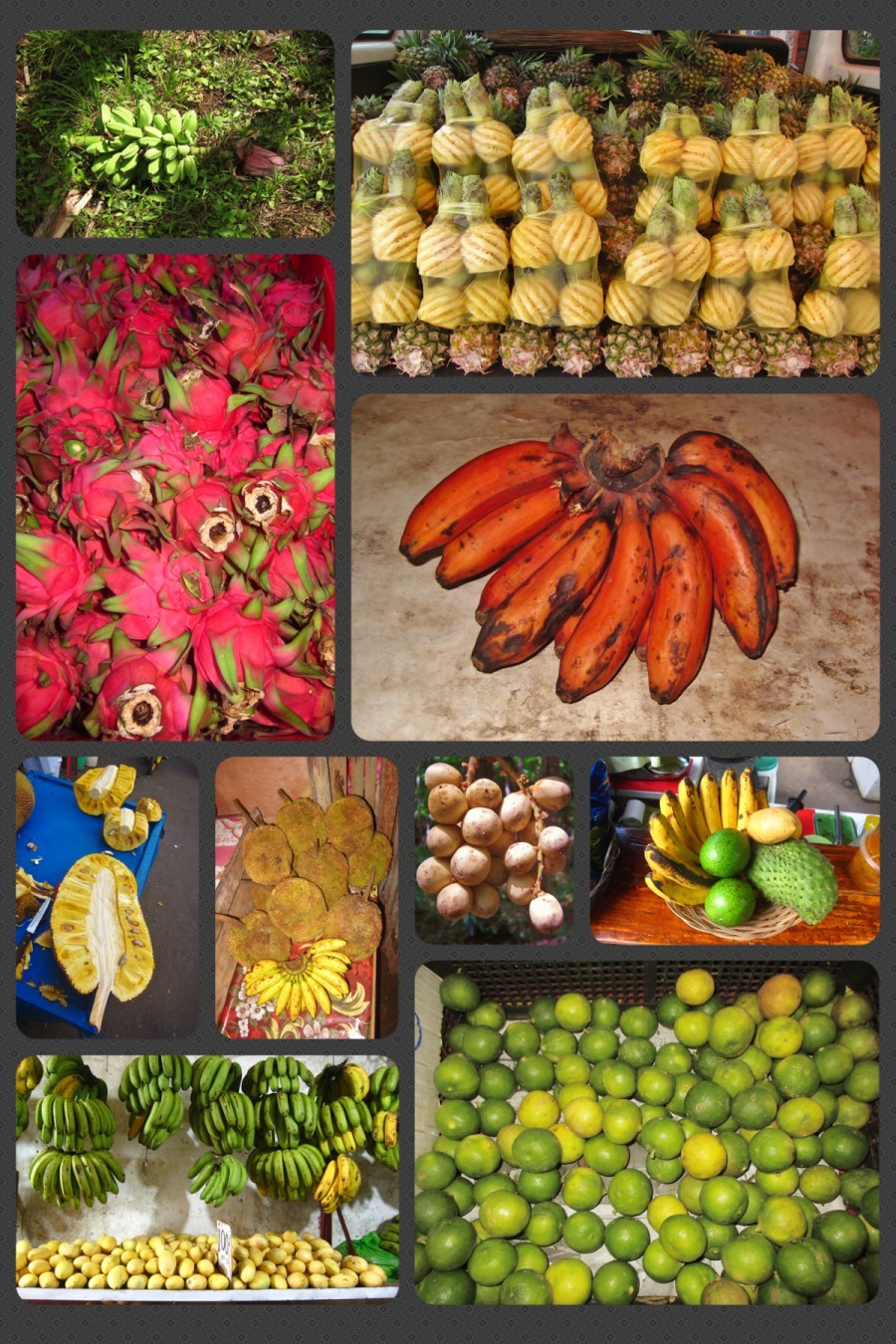
Review of tropical fruits of Asia, although some of them also from South America; such as dragon fruit and guyabano. Calamansi are in the bottom right corner. Please pay attention to the red bananas, because I’ve never seen this variety in Europe.
Pomegranate – is quite well known, but a very special fruit on my list. These fruit originate from Iran, but I ate them mostly in Armenia. In the entire Caucasus region pomegranates have become a symbol of health, life and culture in the countries of the given region. Today pomegranates also grow in India, in Malaya, Africa, in the Caribbeans and the entire Mediterranean region. Pomegranates are also present in Greek mythology as symbols of rebirth and fertility, though not only. Pomegranate fruit has been used throughout history and practically every religion as a symbol of the main beliefs and ideals of humanity; namely life and death, rebirth and eternal life, fertility and marriage, and abundance. In Islam, the Koran mentions that pomegranates grow in the gardens of Paradise, and in Hinduism and in Persian and Chinese culture, a pomegranate is also considered to be a symbol of fertility and procreation, associated with the goddesses of the earth.
Pomegranates grow on green bushes, about 5-10m high, and it is interesting that most people know grenades well, although not many have tried them. Pomegranates hanging on bushes strike with the eyes at the background of other fruits, because it is the size of a large orange, it has rubbery skin and a ruby color, with a green goblet at the stalk. In addition, the pomegranate does not resemble any other fruit, because after opening, we see a dense set of seeds located among the white, spongy mass. Although the white mass surrounding the seeds is edible, the seeds are our target. Even though juicy pomegranate seeds can be eaten with a spoon, so they do not stain fingers and clothes in red; nevertheless, more often pomegranates are used for producing juices and syrups, for its health benefits. When I traveled through Armenia and Georgia, I also saw pomegranate tea and pomegranate wine.
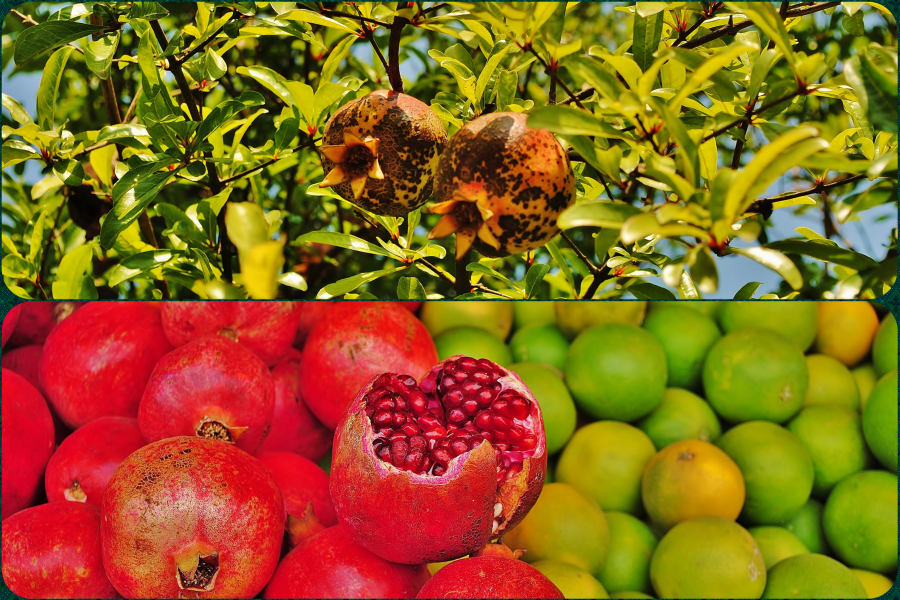
Pomegranates taste well and have health benefits. The picture on top I took in Armenia, and the bottom one in Iran.
According to the research, grenades are one of the healthiest fruits in the world. Pomegranates have a lot of vitamin C and E, and more antioxidants than found in green tea and red wine, which helps, for example, in removing swelling. Pomegranates also help in the fight against Alzheimer’s disease, improve memory, and, according to conducted research, also inhibit the development of prostate cancer. Pomegranate juice can also reduce intestinal inflammation and improve digestion, is good for digestion, inflammation of the joints, and is very good for the heart. In addition, pomegranate juice helps with sterility, and increases testosterone levels, which promotes sexual activity.
In the Middle East and India, pomegranates were used against diabetes, because they help reduce resistance to insulin and lower blood sugar levels. I also recommend pomegranate juice to athletes, because it strengthens performance, it helps to reduce pain and regenerate strength, and it reduces damage caused by exercises.
Dates – are the last fruit on my list, and I describe them also because they come not from Southeast Asia, but from West Asia. As far as I know, dates are originally from Iraq, but now they are also popular in Iran and the Arab countries of North Africa. According to research, dates have existed on Earth for about 50 million years. I personally tried the best dates in Iran, and some I picked straight from palm trees in Persian cities. When traveling in such countries like Egypt, Morocco, Tunisia, Kuwait, Oman and many others, there are also plenty of dates.
In my opinion, dates are real salvation for Arabs and Persians, because date palm trees grow in a very unfriendly, hot climate, which poor in rainfall. For this reason, on the extremely infertile earth, dates are a guarantee that people would not be hungry, and therefore there is no exaggeration in the fact that Arabs call dates, the “bread of the desert”, whereas date palms are called “trees of life” and “holy trees”. There are currently around 100 million date trees in the world, although 90% are in the MENA countries (“Middle East and North Africa”). There are over 3000 types of dates in the world, and they differ in size and colour.
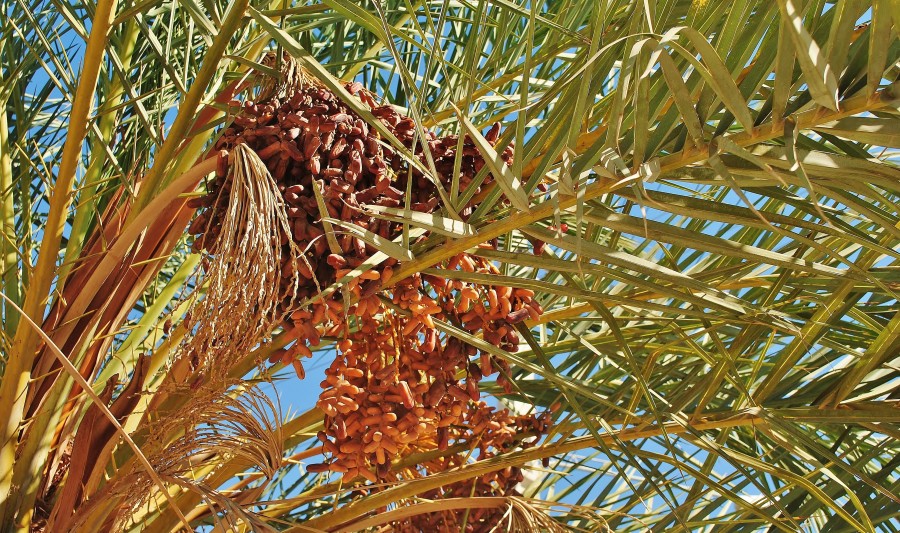
Iranian dates. I took this picture on the street, in the city of Tabas. By the way, when at a traditional bazaar in Tehran, one must buy the world famous dates from Iran.
Dates are good when they are fresh, so straight from the tree, although they also very popular when dried, so when they lose about 25% of water. Dates are exported all over the world, but to get to know better the use of those great fruit, one should travel around the Middle East, because these inconspicuous fruit are used in many dishes; to meats and salads, as well as for baking breads and in desserts. Dates can be also cut and added to breakfast cereals. Dates on their own are very sweet and they give impression that they could be chewed.
Apparently, dates with the addition of milk and cinnamon are also an aphrodisiac, but I don’t believe that. It is a legend invented by horny Arabs.
As for the nutritional and health benefits of dates, it will be hard for me to list them all, that’s why I will only mention the most important ones. Dates contain valuable vitamins from groups A, B and C. Dates add energy and are rich in natural sugars, such as glucose, sucrose and fructose. People who regularly eat dates would notice that they have more energy, and don’t need to take additional vitamins. For that reason, dates are perfect as a quick snack. Dates are also good for digestion, they have a lot of proteins and are rich in iron, reduce the risk of heart attack and they strengthen the nervous system.
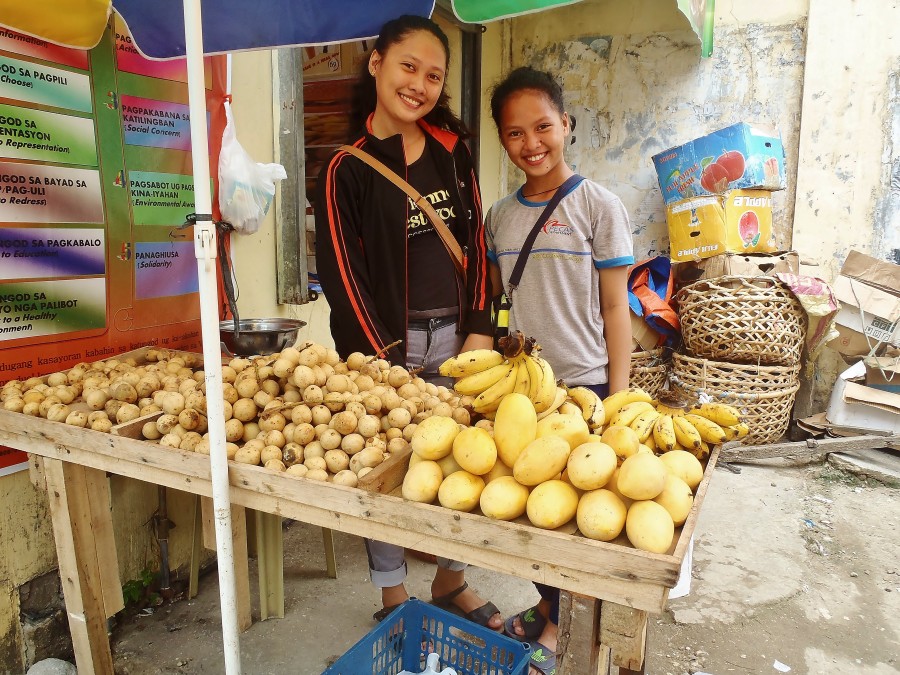
Young Filipinas selling lanzones, bananas and mangoes.
In addition, they have a good effect on bones and skin elasticity due to vitamins C and D. However, dates have a lot of calories, what my readers may take as a warning.
Fruit as a metaphor in the Bible
The Fruit of the Holy Spirit – is a metaphor used by Saint Paul to describe the virtues that are the result of the Holy Spirit’s influence on the personality of man. It is found in Galatians 5: 22-23.
The Catholic tradition follows the version of the Galatians from the Vulgate, listing 12 fruits; and not 9 as it is in the Protestant church. They are: charity, joy, peace, patience, kindness, goodness, generosity, gentleness, faith, modesty, self-control, and chastity. This tradition was defended by Thomas Aquinas in his work: Summa Theologica.
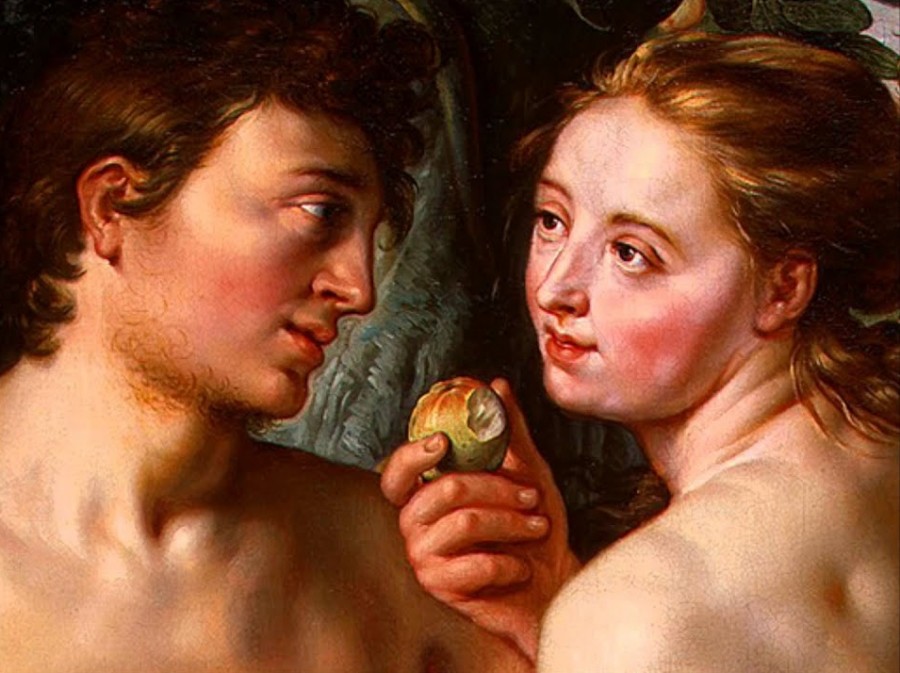
Remember to ask the owner if we can pick fruit from his garden. Eve picked from the wrong tree.
„Watch out for false prophets. They come to you in sheep’s clothing, but inwardly they are ferocious wolves. By their fruit you will recognize them. Do people pick grapes from thorn bushes, or figs from thistles? Likewise, every good tree bears good fruit, but a bad tree bears bad fruit. A good tree cannot bear bad fruit, and a bad tree cannot bear good fruit. Every tree that does not bear good fruit is cut down and thrown into the fire. Thus, by their fruit you will recognize them.
Matthew 7:15 – 20
Summary of the fruits of Asia
In this article I wanted to show that Asia is not just made of beautiful landscapes, ancient cities and sophisticated cuisine. Of course, Asia is a fascinating continent of many cultures and civilizations, but every time I travel around Asia, I discover something new that interests me, and what I want to write about. As we can see, Asia also has many wonderful tropical fruit, that have a positive effect on health, and most of which are unknown in Europe.
I hope that when I continue my travels, I will be able to enrich this article with descriptions of new – tropical fruit of Asia. Let’s remember that a real traveller never stops discovering, therefore the ambitious ones could find a lot more fruit in distant bazaars and uneven trails of Asia. It could be for example a Chinese persimmon, or a velvet apple from the Philippines. Actually, this article could never end.

Rambutans are common fruit throughout Southeast Asia.
Fruit or Fruits (the use of English)
Fruit can be used as an uncountable noun or a countable noun, in which case the plural form would be fruits.
- Nouns for classes of foodstuff (fruit, meat, cheese, etc.) are usually uncountable, but they take a countable sense when we talk about different varieties (a wide selection of cold meats, fruits and cheeses). Therefore, if you want to talk about different kinds of fruit, you use fruits.



































